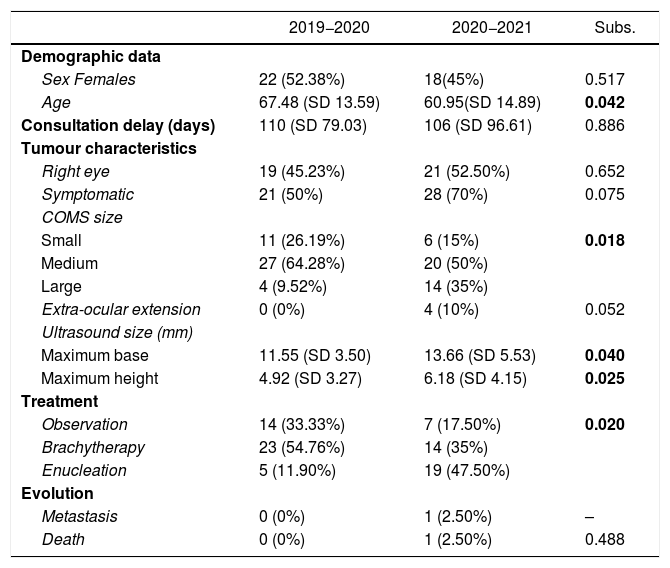To analyse the impact of the COVID-19 pandemic on the diagnosis and management of uveal melanoma (a tumour included in the Orphanet catalogue of rare diseases) in a Spanish national reference unit for intraocular tumours during the first year of the pandemic.
MethodAn observational retrospective study of patients with uveal melanoma in the National Reference Unit for Adult Intraocular Tumors of the Hospital Clínico Universitario de Valladolid (Spain) was performed, analysing the pre- and post-COVID-19 periods: from March 15, 2019 to March 15, 2020 and from March 16, 2020 to March 16, 2021. Demographic data, diagnostic delay, tumour size, extraocular extension, treatment and evolution were collected. A multivariable logistic regression model was used to identify factors that were associated with the variable: enucleation.
ResultsEighty-two patients with uveal melanoma were included, of which 42 (51.21%) belonged to the pre-COVID-19 period and 40(40.78%) to the post-COVID-19 period. An increase in tumour size at diagnosis and in the number of enucleations was observed during the post-COVID-19 period (p < 0.05). Multivariable logistic regression demonstrated that both medium-large tumour size and patients diagnosed in the post-COVID-19 period were independently related to an increased risk of enucleation (OR 250, 95%CI, 27.69–2256.37; p < 0.01 and OR 10; 95%CI, 1.10–90.25; p = 0.04, respectively).
ConclusionsThe increase in tumour size observed in uveal melanomas diagnosed during the first year of the COVID-19 pandemic may have favored the increase in the number of enucleations performed during that period.
Analizar el impacto de la pandemia por COVID-19 en el diagnóstico y manejo del melanoma uveal (tumor incluido en el catálogo de enfermedades raras por Orphanet), en una unidad de referencia nacional española de tumores intraoculares, durante el primer año de pandemia.
Materiales y métodosSe realizó un estudio retrospectivo observacional de pacientes con melanoma uveal en la Unidad de Referencia Nacional de Tumores Intraoculares del Adulto del Hospital Clínico Universitario de Valladolid (España), analizando los periodos pre- y post-COVID-19: del 15 de marzo de 2019 al 15 de marzo de 2020 y del 16 marzo de 2020 al 16 de marzo de 2021. Se recogieron datos demográficos, demora diagnóstica, tamaño del tumor, extensión extraocular, tratamiento y evolución. Se utilizó un modelo de regresión logística multivariable para identificar los factores que se asociaron a la variable: enucleación.
ResultadosSe incluyeron 82 pacientes con melanoma uveal, de los cuales 42(51,21%) pertenecían al periodo pre-COVID-19 y 40(40,78%) al periodo post-COVID-19. Se observó un aumento del tamaño tumoral al diagnóstico y del número de enucleaciones durante el periodo post-COVID-19 (p < 0,05). La regresión logística multivariable demostró que tanto el tamaño tumoral mediano-grande como los pacientes diagnosticados en el periodo post-COVID-19 estaban relacionados de forma independiente con un riesgo mayor de enucleación (OR 250, IC95%, 27,69-2256,37; p < 0,01 y OR 10; IC95%,1,10-90,25; p = 0,04, respectivamente).
ConclusionesEl incremento del tamaño tumoral observado en los melanomas uveales diagnosticados durante el primer año de pandemia por COVID-19 pudo favorecer el aumento de las enucleaciones realizadas en dicho periodo.







